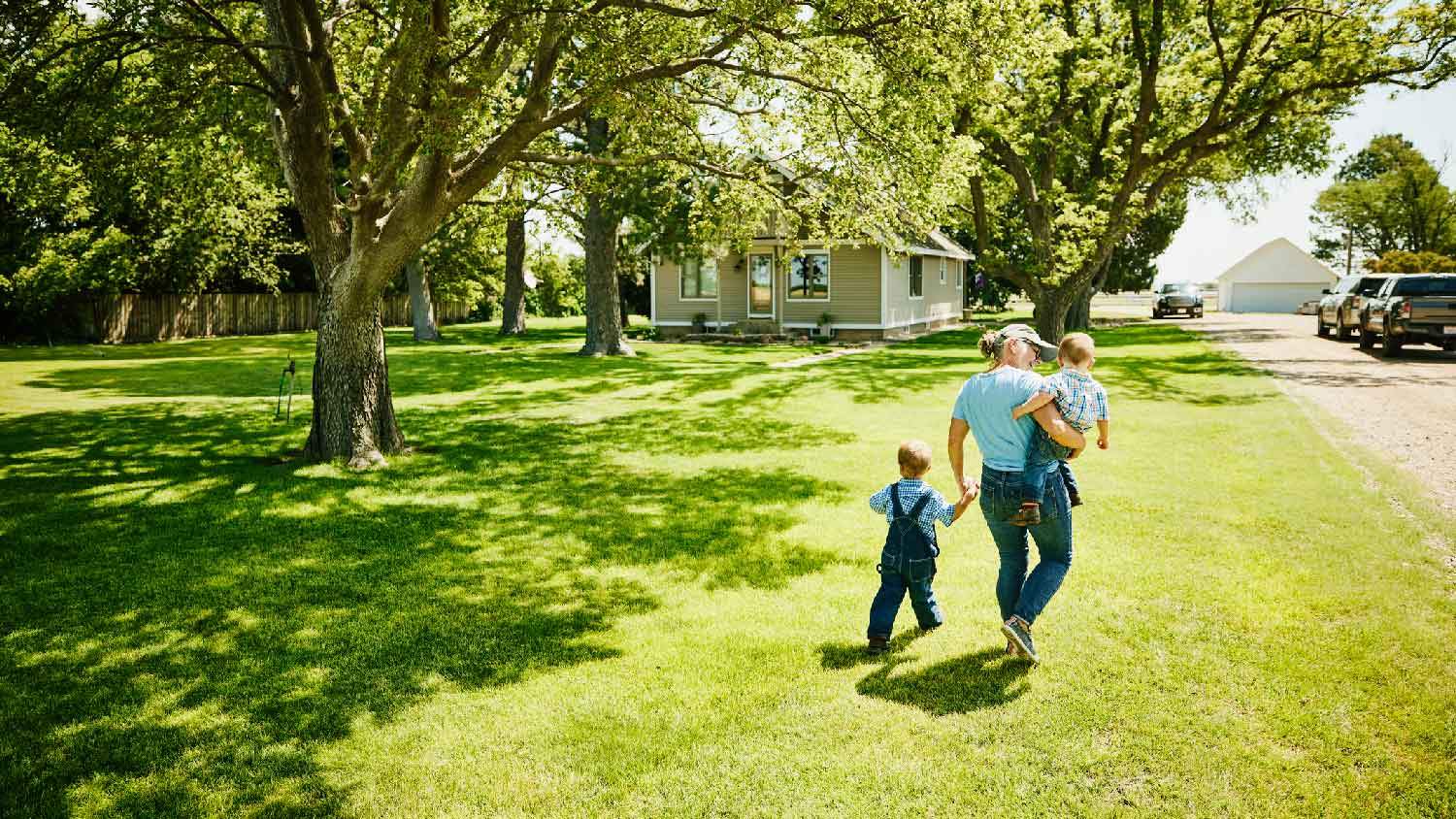How To Make Grass Green: Become the Envy of the Neighborhood
Making grass greener and thicker means you've got to give it some TLC


We all want to learn how to make grass green, lush, and thick so it’s the perfect shade and style—but it's not as easy as laying new sod and calling it good. Grass often fades, develops mysterious dry or dead patches, or suddenly thins so the ground beneath is visible. Thankfully, you can take some simple steps to remedy this and get a vibrant, dense, super-green lawn carpet.
How to Make Your Grass Green
There are several ways to make your grass greener than a shining emerald.
Improve Your Soil With Testing
Grass needs nutrients and the right conditions to thrive, starting with good soil management. Unhealthy soil leads to unhealthy grass. So instead of diving in and treating the obvious symptoms, go to the root of the problem (literally) to fix your soil and give your grass roots ideal growing conditions.
Here’s how to do it:
Test your soil to find out pH and nutrient levels.
Based on your test results, amend the soil nutrient profile with the right slow-release fertilizer.
Amend soil pH by applying lime if it's too acidic, and rich compost or sphagnum peat moss if it's too alkaline. You're aiming for a pH of 5.5 to 6.5 for the best grass growth.
Follow a fertilizing schedule. Fertilize in early spring, then every 4 to 6 weeks with a slow-release fertilizer during the growing season.
Aerate Your Lawn
If your kids and dog spend lots of time romping around in the grass, eventually, your lawn will become compacted. This is most common with clay soils, causing it to become dense and tightly packed so grass roots can't get enough air or food.
Aerating the lawn helps loosen the soil, letting food, water, air, and nutrients travel through and nourish your grass. And aeration provides better conditions for grass to develop a strong, healthy root system.
You can rent a machine and tackle the job yourself, or hire a pro. Lawn aeration costs an average of $129.
Dethatch Your Lawn
Sometimes your lawn has to look worse before it can get better. That’s the case for dethatching a lawn: it’s necessary, but it does temporarily damage the living grass.
Dethatching removes dead organic matter that creates a thick, spongy layer at the base of your lawn. This matter encourages moss growth, starving your grass of moisture and the benefits of fertilization. But when you dethatch your lawn, you let water and nutrients reach the soil, improve airflow, and promote thick growth.
You can dethatch your lawn yourself, hire a garden pro for a one-off project, or add it as part of your regular lawn maintenance service.
Gently Fertilize Your Lawn
Because dethatching is a traumatic process, your grass needs a little TLC to recover. Start by giving the grass a thorough, deep soaking, then apply a half-strength dose of slow-release fertilizer, and water again. These extra steps help take the fertilizer down to the roots and encourage deep, downward root growth.
If you're not going to overseed, you can also apply a top dressing of well-rotted manure or fine compost.
Overseed Your Lawn
After you've aerated, dethatched, and fertilized, overseeding is the next smart step to getting a thick, green lawn. Overseeding involves sowing grass seed over your existing lawn. And, as you've already aerated and dethatched, the seed can make good contact with the soil and achieve a high germination rate. Consult a local lawn specialist to find out which grasses thrive in your area.
Here’s how to overseed your lawn:
Mow the grass short, preferably under 2 inches.
Spread lawn-starter fertilizer over the grass to create a nutrient-rich layer that helps the seed quickly develop strong roots.
Sow grass seed liberally over the existing lawn.
Use the back of a rake to gently press the seed into the grass, helping it get closer to the soil.
Add a light top dressing of high-quality compost and rake it through.
Let the lawn grow, and don't mow it before it reaches about 3 inches.
Mow Your Lawn
The best mowing schedule to maintain a lush lawn depends on the type of grass and your local climate. If you recently planted or re-seeded your lawn, allow the seedlings 2 to 3 weeks to grow tall and resilient enough for mowing.
Once the new grass matures, mow regularly, but remember to never mow more than ⅓ of the grass’ height to avoid stressing and weakening it. Keep an eye on the changing growth patterns of your type of grass—certain species will grow at different rates during the spring, summer, and fall.
Even the time of day and lawn conditions dictate the best time to mow. The best time to mow your lawn is in the early evening when it's neither wet from recent rain or overly dry from the hot sun. You may compact soil with the mower if it's too wet and stress out the blades if they're struggling with drought.
Sharpen Mower Blades
Sharpen your mower blade at the start of every season to prevent jagged cuts that turn brown and injure the grass. Depending on the size of your lawn, a reel mower could be more beneficial for your grass than a gas mower since it improves grass health.
Water Regularly
For the first couple of weeks after overseeding, you'll need to water the lawn regularly—at least every other day in warm, dry weather, as the grass won't have a deep root system yet.
After two weeks, move to watering deeply once or twice a week. This schedule encourages the new grass to grow deep, strong roots that will eventually take up water from deep in the soil during dry spells.
Yet again, it's important to know what your grass species needs in your unique local climate. In most cases, water your grass between 1½ and 3 inches each week—either at once or split between two waterings. Adjust the final amount based on recent precipitation.
Protect Against Pests
Unwelcome guests like grubs and webworms can throw off your goals for a thick green lawn as quickly as drought or disease. Keep in mind that not all insects and animals count as invaders. Maintaining a healthy lawn comes down to balancing and maintaining a healthy ecosystem.
The most common lawn-damaging pests include:
You may also encounter biting pests like mosquitoes, ticks, and mites. Signs of pests include yellow or brown patches, fragile grass blades, or bites when you spend time outside.
Maintain a healthy insect ecosystem by balancing the moisture and thickness of your lawn. Ensure proper drainage, avoid overwatering, and consider leveling any area gathering standing water. When necessary, treat with organic or chemical-based insecticide or a fertilizer with insecticide in the recipe.
Ward Off Weeds
Similarly, keeping a proper watering, aerating, and fertilization schedule will discourage invasive weeds from stealing the show. Thick grass won't leave enough space and nutrients for weeds to thrive.
Common weeds—such as dandelions, crabgrass, chickweed, or quack grass—could also be trying to tell you something about your soil. Different weeds thrive in soil that is compacted, highly acidic or alkaline, clay-heavy, or dancing in an imbalance of nutrients.
The most common invasive plants include:
Crabgrass
Chickweed
Quack grass
White clover
Ragweed
Oxalis
When getting rid of existing plants, consider a chemical-free DIY approach to removing weeds to avoid throwing off the natural balance of your lawn.
Learn Your Grass Type
The type of grass on your property dictates proper lawn care and which method is best for keeping your aesthetics on point. Additionally, understanding the pre-existing grass types helps avoid mix-ups later when planting new grass, as some types don’t play nice with others. In other words, learning how to identify lawn grass is important.
The primary distinction is between cool-season and warm-season grasses. If you live in a Northern state, you likely have a type of cool-season grass, as it withstands large temperature fluctuations. Common cool-season grasses include fine fescue, tall fescue, Kentucky bluegrass, and ryegrass.
If you live in the South, your lawn is likely populated with warm-season grass that thrives in high temperatures but struggles during the winter. Common warm-season grasses include Bermuda grass, zoysia grass, and centipede grass.
All grasses boast unique shapes and defining physical characteristics, making it fairly simple to match up physical details to a name and location. For instance, fine fescue has a gray-to-green color with pointed tips, while centipede grass boasts a light green color and boat-shaped tips.
Maintain Your Lawn
Regular maintenance is required to keep your lawn looking great, so you might want to hire a local lawn care service to handle the job for you. You can also book lawn care services using an Angi Key membership.
DIY vs. Hiring a Pro
If you go the DIY route, you'll save on labor costs, but you'll need to purchase all the tools and supplies, including a dethatcher, seed, and fertilizer. Plus, it takes time and energy. If you hire a professional lawn care service in your area, you'll pay more in labor, but you won't have to worry about getting the right supplies or making time in your busy schedule for hours of lawn care.
Lawn repair and maintenance costs between $50 and $200 per month for regular servicing. Buying a monthly package may get you a deal on extra services like aeration, overseeding, and weed removal. But whether you're going it alone or hiring a pro, the steps for keeping your lawn the envy of your neighbors are the same.
How To Make Your Grass Green Fast
Hosting a backyard event and need your grass to green ASAP? There are some ways to hasten the transformation process to get that bright, verdant lawn quickly.
Iron supplements: Iron slightly speeds up grass growth and brings out deeper and richer shades of green due to rising chlorophyll levels. Apply an iron supplement to unlock the benefits. Follow the instructions closely as overspraying is dangerous to the grass.
Overseed: While you want to exercise caution when adding supplements, overseeding your lawn is a great method to quickly increase the aesthetics of your yard. If your lawn looks green, but dull and thin, plant new grass seeds throughout the year to make it fuller.
Use nitrogen-rich fertilizer: Nitrogen speeds up grass growth and brings about a richer green color. Use a fertilizer that is rich in nitrogen to unlock these benefits, but follow the instructions carefully. Too much nitrogen is detrimental to the health of your lawn.
Mow properly: It is important to mow the grass to the correct height, as this hastens the greening process. The appropriate height depends on the grass type, but a good rule of thumb is to mow down to anywhere from 2 to 4 inches high. Also, keep an eye on those blades. Dull blades prevent clean cuts and slows down the brightening process.
Paint the grass: Yes, really. The fastest way to a green lawn is to cheat. Purchase lawn-safe green colorants at local home improvement stores or make your own by mixing together Epsom salt, fertilizer, and green food coloring. Combine one pound of liquid plant fertilizer, four pounds of Epsom salt, and ¼ cup of green food coloring. This DIY method is enough dye to cover 1,000 square feet.
Ginny Bartolone contributed to this piece.
Frequently Asked Questions
The best type of fertilizer depends on the type of grass and your desired end result. Generally speaking, slow-release fertilizers are best for grass, as they gradually release nutrients into your soil instead of all at once, which meets the needs of many grass types. However, the tradeoff is that slow-release fertilizers contain phosphorus, which negatively impacts local water quality. Also, some grasses require different formulations to meet the demands of the soil. Test your soil to see how acidic or alkaline it is before choosing a fertilizer.
The best time to apply fertilizer to your lawn is in early fall, though some climates necessitate a different schedule. In most cases, avoid fertilizing late into fall, as this opens up your yard to winter injuries and poor health (though this is a great time to kill weeds.) You should avoid early spring fertilization, as this helps the grass leaves grow, but at the expense of developing root systems. Remember to water your lawn after fertilizing to increase its effectiveness and reduce the likelihood of runoff during a rainstorm.
There are plenty of products to help green up your grass. Try an iron supplement spray or fertilizer that is rich in nitrogen. You can also apply a thin layer of compost on top of your lawn at the beginning of spring to give the grass a nutrition boost, which helps it achieve that bright color you are looking for.





- Why Is My Grass Turning Yellow? 15 Solutions to Try
- 12 Mistakes That Are Killing Your Lawn
- Quick Curb Appeal: 10 Tips That’ll Turn Your Grass Green Fast
- 7 Must-Know Tips for How to Keep Grass Green, Healthy, and Thriving
- How Long to Water Grass for a Lush Lawn—and How Often to Do It
- Why Your Grass Keeps Dying (And What to Do About It)
- Can You Overwater Grass? How to Avoid This Common Mistake
- How to Make Bermuda Grass Thicker: 11 Tried-and-True Tips
- Here’s How Long Grass Grows If You Don’t Mow Your Lawn (And Why You Really Need To)
- The Beginner-Friendly Guide to Growing the Greenest Grass










